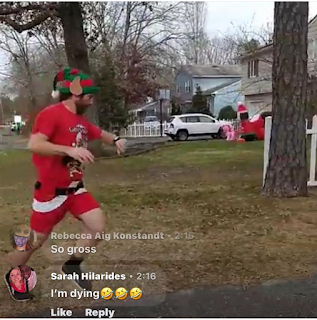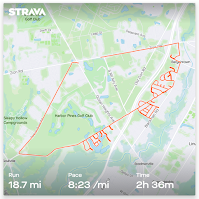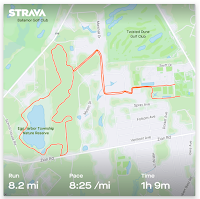So Christmas 2020 was a little different than past ones. And why shouldn’t it have been, pretty much all of 2020 felt out of the ordinary thanks to COVID. This year we found ourselves at home rather than visiting family. Without the family visits that our normal holiday routine revolves around, I tried to do something a bit festive that all of our friends and family near and far could enjoy. I ran an egg nog mile. There was also still the question of whether I would enjoy it or not.
 |
| Southern Comfort Egg Nog! |
 |
| First glass down! |
The anticipation for the run was a bit unnerving. Mentally I was preparing to eventually spew all of the egg nog back up at some point. The thought of which in itself unsettled my stomach. I’m not a huge egg nog fan to begin with, but I will have an occasional glass around Christmas. However, it’s usually a few servings for the entire month of December, not 12 servings chugged while running a mile. While preparing the morning of the event I was spending entirely too much time imagining what egg nog would taste like in projectile vomit form.
While combating this internal struggle, I set up the Facebook live stream so friends and family could watch in real time. Shortly after going live, the clock started and I chugged my first glass of egg nog. It went down quickly and didn’t upset my stomach. I made the quarter mile out and back on our street and grabbed my next glass. The second one was tougher to get down. Not because of stomach issues, it was just that I was breathing heavy from sprinting the quarter and was having trouble to down the thick egg nog while trying to catch my breath for the next run. My stomach still felt fine during the second quarter and I actually picked up the pace a little during that lap. The third glass took a little longer to drink and my stomach started feeling full while chugging it. It didn’t feel like it was upset, just full. I got it down and still managed to run my third quarter faster than my first. The last glass was the toughest to drink. At one point while trying to chug it I gagged a little and thought that I might barf. Thankfully I didn’t and was able to get it down and run my final lap.
 |
| Focused on the time. |
I felt the egg nog in my stomach the most during this final lap. It didn’t feel like I was going to lose it while running, but I could feel it just sloshing around in there. I finished in about 8:27 without any vomiting penalties (breakdown of time in table below). Once finished I began feeling the worst of it. I was having hot flashes and wondering if I was about to vomit at any moment as I pushed my kids on the swing in our front yard. It wasn’t pleasant, but it passed after a couple hours. By dinner time I was pretty much feeling back to normal.
The egg nog I drank contained 190 calories per serving. My 12 servings during the mile I ran delivered a whopping 2,280 calories into my system in less than 8.5 minutes. No wonder why I felt like I was going to vomit. Would I recommend others to try this? Yes! Would I do it again? Again, yes! But not until next Christmas and hopefully in person with more people.















































